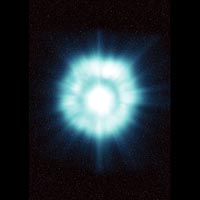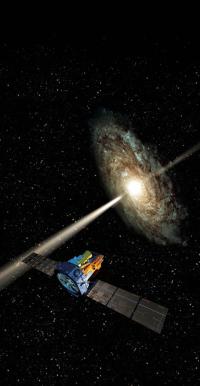|

26 June 2003
from
EuropeanSpaceAgency Website

Artist's impression
of a gamma-ray burst
Cold War intrigue, international
politics, and hi-tech astronomy were the key ingredients for one of
the most amazing and mysterious scientific discoveries of all time,
which took place exactly 30 years ago.
Discovered in 1973, gamma-ray bursts (GRBs) are the most energetic
explosions in the Universe and, even today, astronomers have still
not found out what is triggering them. However, the situation is not
exactly the same as it was three decades ago - ESA's space missions
Integral and XMM-Newton are closing in on the answers.
In 1963, the world's superpowers signed the Nuclear Test Ban Treaty,
which prevented the tests of nuclear weapons underwater, in the
atmosphere or in outer space. To make sure the Treaty was not being
violated, the United States launched a series of military
satellites, called Vela, equipped with X-ray, gamma-ray and neutron
detectors. All three types of emission are expected from a nuclear
blast.
The Vela satellites did not detect any violations, but they did
detect something unexpected — sixteen blasts in the gamma-ray range,
but without the characteristics of a nuclear weapon. Registered
between 1969 and 1972, they did not even come from the Earth's
surface. This puzzled the scientists, as these 'bursts' must either
be very close or very powerful.
In 1973, Ray W. Klebesadel and
his colleagues published the famous 'discovery paper',
'Observations of Gamma-Ray Bursts of Cosmic
Origin,' but without a convincing explanation for the events.
The mystery excited astronomers as over 200 distinct theories were
soon proposed to explain the bursts. However, there was an obvious
lack of data — it was not even possible to determine whether the
blasts happened in our own Galaxy, or thousands of millions of
light-years away.
Only when more gamma-ray satellites were launched did things begin
to improve. NASA's Compton Gamma Ray Observatory was
launched in 1991, to which European scientific institutes and ESA
contributed with the Imaging Compton Telescope. Since then, this
satellite has discovered one GRB happening randomly almost every
day, coming from any direction in space and lasting for a few
seconds. The uniform distribution of GRBs across the sky convinced
astronomers that they most likely occur outside the Milky Way. If
they were inside it, they should be seen mainly near the spiral
arms, where stars are more numerous.
This idea was supported in the late 1990s when apparent counterparts
to these GRBs were identified in distant galaxies. If GRBs are so
far away, however, their energy release must be gigantic, with the
intensity of millions and millions of Suns.
Thus the core mystery is not yet solved:
what kind of astronomical object could explode so catastrophically?

Artist's impression
of Integral
Thanks to missions like ESA's telescopes
Integral and XMM-Newton, the solution is now closer.
Integral, launched in October 2002, is
today the best-prepared telescope for an in-depth study of GRBs.
When a GRB occurs in the centre of Integral's field of view about
once a month, four different instruments 'dissect' the event
simultaneously. XMM-Newton complements Integral's work by aiming at
the 'scene of the crime' as quickly as possible, to analyze the
afterglow of the burst in X-ray wavelengths.
These and other observations have recently helped astronomers to
select two favorite hypotheses for GRBs. They could be generated by
colliding neutron stars (ultra-dense dead stars) or they could be
caused by the explosions of supermassive stars at the end of their
lives, so-called 'hypernovae'. Recent results provide further
evidence that at least some GRBs are associated with hypernovae
explosions.
Christoph Winkler, ESA's Integral Project Scientist, said,
"The hypernova model sounds
convincing, but others cannot still be ruled out. Of course the
situation of GRB research has changed dramatically in the last
decade, but we still need many more measurements to reach a
final answer to what is causing these events."
Fred Jansen, ESA's XMM Project
Scientist, agrees on the need for both more statistics and
cooperative work and said,
"We try to follow Integral
announcements as quickly as we can, because we know that the
solution to the mystery will come from observations with
different telescopes."
With such detectives on this case, no
doubt the depths of space won't be able to keep their secret for
long. It's just a matter of time…
|


